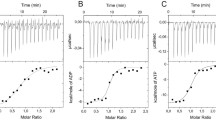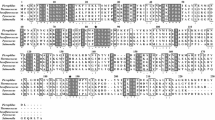Abstract
It has been shown that PPi, methylenediphosphonate, and ATP act as effectors of Escherichia coli inorganic pyrophosphatase (E-PPase), and that they compete for binding at the allosteric regulatory site. On the basis of chemical modification and computer modeling of a structure of the enzyme-ATP complex, a number of amino acid residues presumably involved in binding effectors has been revealed. Mutant variants Lys112Gln, Lys112Gln/Lys148Gln, and Lys112Gln/Lys115Ala of E-PPase have been obtained, as well as a modified variant of wild type E-PPase (Adwt PPase) with a derivative of ATP chemically attached to the amino group of Lys146. Kinetic properties of these variants have been investigated and compared to the earlier described variants Lys115Ala, Arg43Gln, and Lys148Gln. Analysis of the data confirms the proposed location of an effector binding site in a cluster of positively charged amino acid residues including the side chains of Arg43, Lys146 (subunit A), Lys112, and Lys115 (subunit B). Lys112 is supposed to play a key role in forming contacts with the phosphate groups of the three studied effectors.
Similar content being viewed by others
Abbreviations
- E-PPase:
-
E. coli inorganic pyrophosphatase
- Y-PPase:
-
S. cerevisiae inorganic pyrophosphatase
- PCP:
-
methylenediphosphonate
- Adwt PPase:
-
pyrophosphatase chemically modified with the dialdehyde derivative of ATP at the amino group of Lys146
References
Sitnik, T. S., Vainonen, J. P., Rodina, E. V., Nazarova, T. I., Kurilova, S. A., Vorobyeva, N. N., and Avaeva, S. M. (2003) IUBMB Life, 55, 37–41.
Vainonen, J. P., Vorobyeva, N. N., Rodina, E. V., Nazarova, T. I., Kurilova, S. A., Skoblov, J. S., and Avaeva, S. M. (2005) Biochemistry (Moscow), 70, 69–78.
Sitnik, T. S., and Avaeva, S. M. (2005) Bioorg. Khim., 31, 251–258.
Rodina, E. V., Vorobyeva, N. N., Kurilova, S. A., Belenikin, M. S., Fedorova, N. V., and Nazarova, T. I. (2007) Biochemistry (Moscow), 72, 93–99.
Oganessyan, V. Yu., Kurilova, S. A., Vorobyeva, N. N., Nazarova, T. I., Popov, A. N., Lebedev, A. A., Avaeva, S. M., and Harutyunyan, E. H. (1994) FEBS Lett., 348, 301–304.
Avaeva, S., Ignatov, P., Kurilova, S., Nazarova, T., Rodina, E., Vorobyeva, N., Oganessyan, V., and Harutyunyan, E. (1996) FEBS Lett., 399, 99–102.
Josse, J. (1966) J. Biol. Chem., 241, 1938–1947.
Baykov, A. A., and Avaeva, S. M. (1981) Analyt. Biochem., 116, 1–4.
Sutherland, G. R. J., and Aust, S. D. (1997) Biochemistry, 36, 8567–8573.
Chervenka, C. H. (1972) Methods for Analytical Ultracentrifuge, Spinco Division of Beckman Instruments, Inc., Palo Alto.
Avaeva, S., Grigorjeva, O., Mitkevich, V., Sklynkina, V., and Varfolomeev, S. (1999) FEBS Lett., 464, 169–173.
Moiseev, V. M., Rodina, E. V., Kurilova, S. A., Vorobeva, N. N., Nazarova, T. I., and Avaeva, S. M. (2005) Biochemistry (Moscow), 70, 858–867.
Smirnova, I. N., Kudryavtseva, N. A., Komissarenko, S. V., Tarusova, N. B., and Baykov, A. A. (1988) Arch. Biochem. Biophys., 267, 280–284.
Nessler, S., Fieulaine, S., Poncet, S., Galinier, A., Deutscher, J., and Janin, J. (2003) J. Bacteriol., 185, 4003–4010.
Baykov, A. A., Pavlov, A. R., Kasho, V. N., and Avaeva, S. M. (1989) Arch. Biochem. Biophys., 273, 301–308.
Vener, A. V., Nazarova, T. I., and Avaeva, S. M. (1985) Sov. J. Bioorg. Chem., 11, 431–435.
Samygina, V. R., Popov, A. N., Rodina, E. V., Vorobyeva, N. N., Lamzin, V. S., Polyakov, K. M., Kurilova, S. A., Nazarova, T. I., and Avaeva, S. M. (2001) J. Mol. Biol., 314, 633–645.
Hopfner, K.-P., Karcher, A., Shin, D. S., Craig, L., Arthur, M., Carney, J. P., and Tainer, J. A. (2000) Cell, 101, 789–800.
Arcondeguy, T., Jack, R., and Merrick, M. (2001) Microbiol. Mol. Biol. Rev., 65, 80–105.
Xu, Y., Cheah, E., Carr, P. D., van Heeswijk, W. C., Westerhoff, H. V., Vasudevan, S. G., and Ollis, D. L. (1998) J. Mol. Biol., 282, 149–165.
Butler, B. C., Hanchett, R. H., Rafailov, H., and MacDonald, G. (2002) Biophys. J., 82, 2198–2210.
Author information
Authors and Affiliations
Corresponding author
Additional information
Published in Russian in Biokhimiya, 2007, Vol. 72, No. 1, pp. 118–127.
Rights and permissions
About this article
Cite this article
Rodina, E.V., Vorobyeva, N.N., Kurilova, S.A. et al. ATP as effector of inorganic pyrophosphatase of Escherichia coli. The role of residue Lys112 in binding effectors. Biochemistry (Moscow) 72, 100–108 (2007). https://doi.org/10.1134/S0006297907010129
Received:
Revised:
Issue Date:
DOI: https://doi.org/10.1134/S0006297907010129




